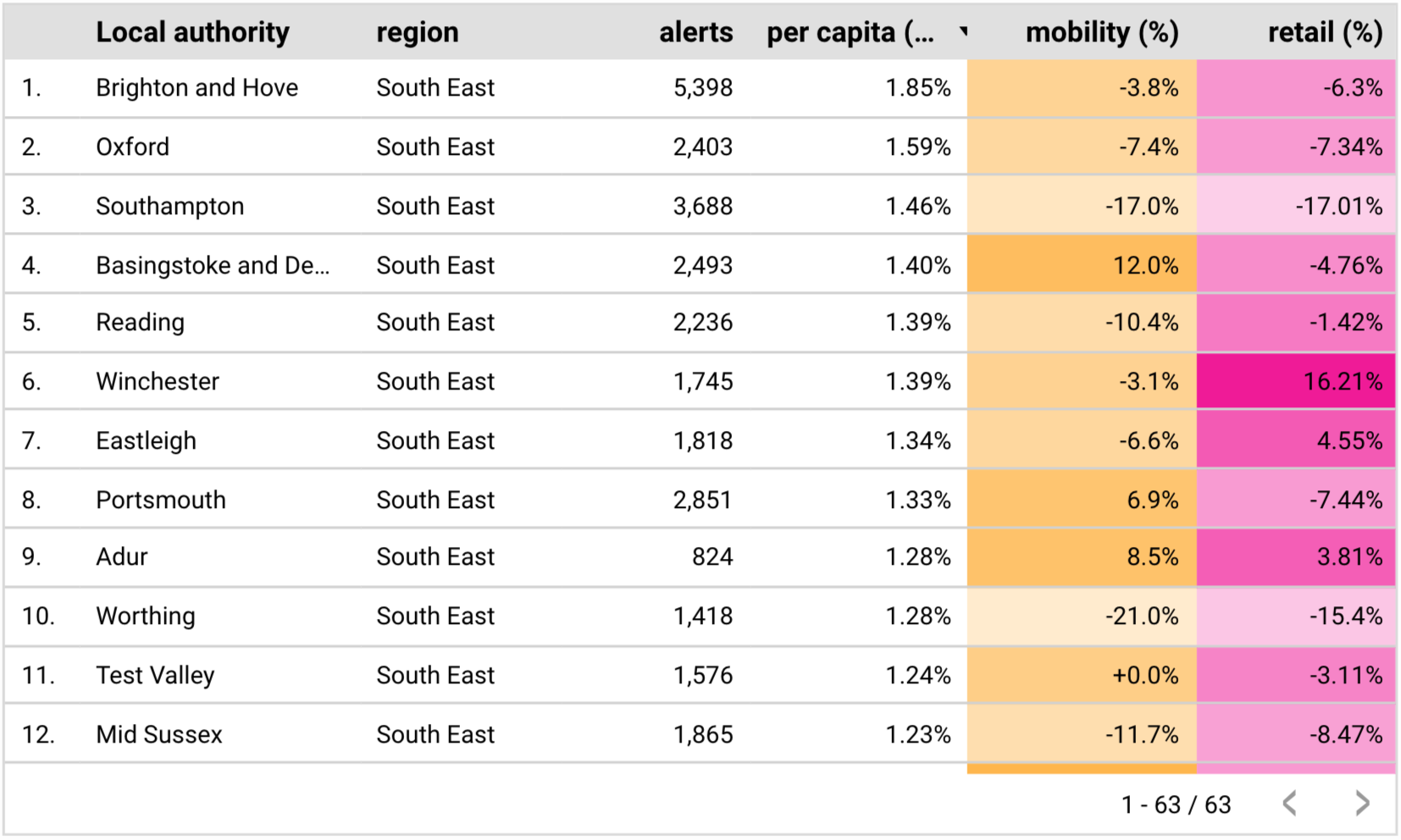
The number of people visiting Brighton’s shops dropped by 6% over the last month, as Huq’s geo-data reveals how the economy of the most ‘pinged’ city in the South East is being impacted by people being told to self-isolate.
In our deep-dive series exploring the link between alerts and the impact on economic activity, today’s focus is on the South East where more than 87,309 NHS self-isolate alerts were sent and the seven days leading up to 14 July. Both general population mobility and retail store visits in the region have taken a dive over the last month.
To do the analysis, our research team used the NHS’ weekly alert statistics by local authority alongside Huq’s mobility data which allows for analysis of footfall and retail store visits by local authority. Our research team produced indices for both measures and compared the June – July change. The most recent data available is for the seven days leading to July 14th. In the round there is a loose correlation (~0.2) between alerts sent and the reduction in movement.
Understanding self-isolation and economic activity
Almost 1% of the population in the South East received instruction to self-isolate in the week analysed, with this number climbing as high as 1.85% in Brighton and Hove. Overall, instruction to self-isolate has contributed to a drop of 3.95% in mobility and a 4.85% decrease in retail store visits in comparison to June.

Among those which have received the most NHS self-isolate alerts Brighton and Hove, which is the 8th most ‘pinged’ city in the UK, has experienced a 3.79% drop in mobility and a 6.3% drop in retail footfall. Oxford, where 1.59% of the population has received alerts has seen a 7% decrease in both mobility and retail store visits.
Few councils in the region have seen general mobility and retail engagement increase despite growing numbers of people being told to self-isolate. These include East Hampshire, where 0.9% of the population have received alerts and mobility and retail activity have increased by 12.99% and 3.64% respectively.
Some coastal towns including Hastings, Folkestone and Dover have received some of the lowest numbers of ‘pings’ in the region (0.64% to 0.47%) however retail store visits in all three has dropped significantly by up to 24% in Folkestone and 22% in Dover. Thanet on the other hand, where ‘pings’ are the lowest in the South East with just 0.4% of the population receiving alerts, has seen retail activity increase by almost 6%.
Methodology:
The data represents change in daily distances travelled, workplace presence and retail store visits since the start of July, ranked by alerts per capita. Huq provides high-street footfall analytics to councils, BIDs, LEPs and policy-makers to help support economic development objectives.
Its market-leading footfall measurement solutions provide a daily measure of footfall across high streets and town centres and the ability to segment trends using census demographics. Community Vision, Huq’s intuitive reporting tool, provides users with the ability to visualise footfall density across high streets and centres along with dynamic catchment area maps.
The platform is built for measurement accuracy and is compliant with the ERDF’s Re-opening the High Street Safely fund, the Welcome Back initiative, Levelling Up Fund and other grant funding initiatives.
To learn more about the data behind this article and what Huq has to offer, visit https://huq.io/.







Sign up to receive our stories in your inbox.
Data is changing the speed of business. Investors, Corporations, and Governments are buying new, differentiated data to gain visibility make better decisions. Don't fall behind. Let us help.













Sign up to receive our stories in your inbox.
Data is changing the speed of business. Investors, Corporations, and Governments are buying new, differentiated data to gain visibility make better decisions. Don't fall behind. Let us help.





